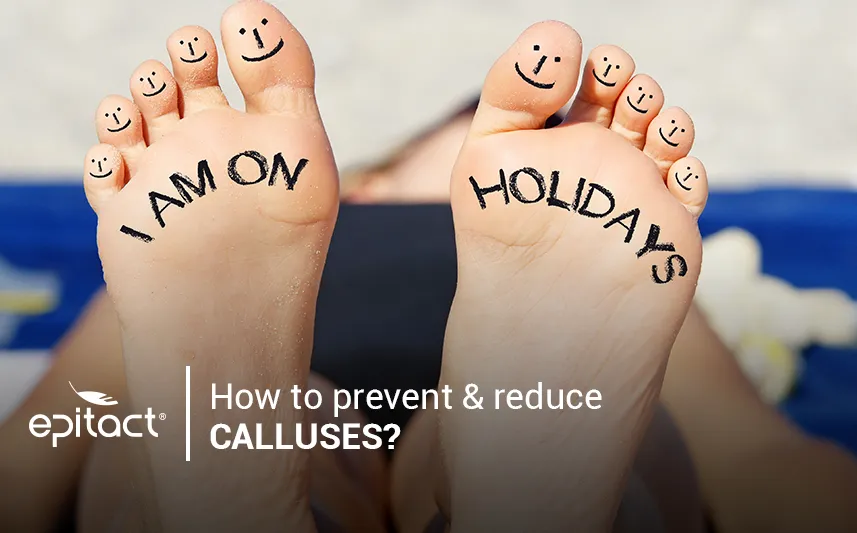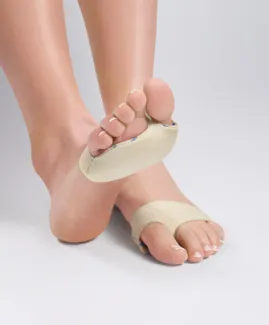
You already had that pain in the ball of your foot caused by a callosity? you just had a callus removed and want to prevent it from coming back? If you want to know how to prevent calluses on feet, you are in the right place. EPITACT® tells you how to avoid or reduce a foot callus!
How to avoid calluses on feet?
A callus is a callosity that appears under the foot, on the heel or on the toes. To reduce the calluses on your feet, several treatments exist. Before that, let us remind you what a callus is and what causes it. It will help you understand how to prevent calluses on feet or how to reduce them.
What’s a callus?
The callus is a thickened area of skin. It commonly forms on the feet or hands, at the base of the fingers or toes. They may also appear on the arch of the foot. These thick and hard pads are made of yellowish keratin, sometimes friable but they usually do not cause pain.
How do foot calluses form?
The foot is composed of a fat pad, which plays a role of a natural pressure distributor. It is made up of fat globules and changes with age under high use. So, it doesn’t correctly carry out its function anymore.
This progressive modification leads to pain on the metatarsal heads. Then, the chronic friction and pressure cause calluses, which form to protect the sensitive areas.
Some calluses appear on the hands with the repetition of movements often associated with a sport or a professional activity. Other smaller calluses may be related to the wearing of a wedding ring or to repeated use of a tool (hammer, screwdriver, etc.). Over time, the repeated movements against the hand pad cause the abnormal thickening of the skin (hyperkeratosis).
Who is concerned by calluses?
People most commonly presenting calluses are women, but men can also be affected. Indeed, wearing high heels or tight shoes that pinch the foot or ill-fitting shoes favours their appearance. The natural fat pad is a structure intended to homogeneously distribute the pressure under the forefoot.
By wearing high heels, the pad supports too much load and can’t play its role to distribute such pressure. Same thing happens with flat shoes or without shoes at all because the foot has a specific structure (for example, a round forefoot will cause calluses under its central part). The presence of a callus involves hyper-pressure on the affected area. In order to distribute the pressure better, the body defends itself with hyperkeratosis.
What are the symptoms?
Calluses are usually painless but they can cause discomfort resulting from the modification of support distribution they imply. These excrescences make the wearing of shoes complicated. Finally, the main reason that pushes people with calluses to consult a specialist is the unsightly appearance.
How to prevent calluses on feet?
To avoid foot calluses, the best thing to do consists in wearing comfortable, quite flat or low-heeled shoes. Shoes with a wide toe box, ideally round-shaped to enable toes to move properly are more appropriate.
In addition, regular care of your feet with massages as well as a proper moisturising and physical activity will prevent many conditions.
Finally, wearing metatarsal pads in dress shoes will prevent calluses on feet. In this way, EPITACT® suggests metatarsal pads* designed to improve the comfort and to reduce calluses on your feet.
How to reduce calluses on feet?
If hard skin has formed on your feet or hands, here is some advice to reduce calluses on your feet or make them disappear. Firstly, sand these callosities with a pumice stone or a file dedicated to this use. To facilitate the process, you can soak your feet in warm water.
Then, take the time to moisturise your feet with creams adapted to dry feet and hands.
Finally, you can wear the EPITACT® metatarsal pads* if you’re suffering from chronic or constant pain.
Now you know how to avoid calluses on your feet or how to reduce them. Do not hesitate to consult a podiatrist for advice. With adapted care, your practitioner will help you stop their development and make them disappear.
The creation of made-to-measure orthopaedic insoles will support and/or correct the functioning of the foot as well as it will allow homogeneous distribution of pressures. Finally, only a change in shoes and movements habits as well as appropriate protections will prevent calluses on feet or their reappearance.
*This solution is a class I medical device that bears the CE marking under this regulation. Carefully read the instructions before use. Manufacturer: Millet Innovation. 09/2021
 Pharmacie
Pharmacie